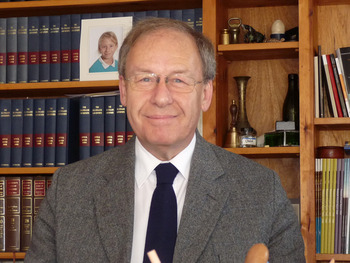Norman Palmer died on 3 October 2016 and was buried at Crickadarn near his home in Wales. Norman was the first editor of the International Journal of Cultural Property. He took up this position in October 1990 when the International Society of Cultural Property entered into a contract with Walter de Gruyter and Company of Berlin as publishers. John Merryman had proposed the Journal and had held meetings with prospective Editorial Board members in Rome, Vienna, and Amsterdam in 1990. Throughout that year, the proposed nature of the Journal had been debated.

Norman Palmer.
The first issue was published in January 1991. Norman wrote an editorial setting out his vision for the Journal. The Journal is an organ of communication among people throughout the world who are interested in questions of cultural property policy, ethics, economics, and law. In addition to refereed articles, it publishes documents, judicial decisions, correspondence, bibliography, and information about meetings and events. Its pages are open to all responsibly held and courteously presented points of view. Norman concluded his editorial: “What follows is simply a beginning. We hope that it will also prove an awakening. If scholarly discourse is enhanced, and if the issues of cultural property receive candid and sympathetic debate within these pages, our purpose will be well served.”
History has shown that the Journal has amply fulfilled his hopes. Norman himself resigned the position of editor in 1995. During his editorship, he had been professor of commercial law at the University of London. He also conducted a post-graduate course in cultural heritage law at University College London. This work, plus an expanding legal practice, meant that he could no longer devote the time necessary to run the Journal as he thought it should be. The editorship was taken over by Patty Gerstenblith from DePaul University in Chicago.
The Journal was fortunate to have a person of Norman’s ability to see it through its formative years. He became the leading British lawyer dealing with cultural heritage issues. He played a variety of official roles: chairman of the Illicit Trade Advisory Panel (2000–05), which successfully advised the government that the United Kingdom should become party to the 1970 Convention on the Means of Prohibiting and Preventing the Illicit Import, Export and Transfer of Ownership of Cultural Property; chairman of the UK Government Working Group on Human Remains, which led to changes allowing national museums to return human remains held in their collections; member of the Treasure Valuation Committee, which recommends to the government the value of treasure finds that come before it; and expert advisor for many years to the Spoliation Advisory Panel, which advises government on claims involving holocaust objects in British museums.
Norman was involved as legal counsel in significant matters such as the return of part of the Sevso Treasure to Hungary and the case known as Islamic Republic of Iran v. Barakat, which dealt with archaeological objects taken from Iran and held by a dealer in London. Together with Geoffrey Robertson, QC, and Amal Clooney, he gave an opinion on the status of the Parthenon Marbles for the Greek government. Together with his wife, Ruth Redmond-Cooper, he founded the Institute of Art and Law in 1995. The institute runs an academic program and publishes books on cultural heritage matters as well as the quarterly journal Art Antiquity and Law.
Norman Palmer was a quiet man of great charm and empathy for other people. The world of cultural heritage law and management will sadly miss him.




